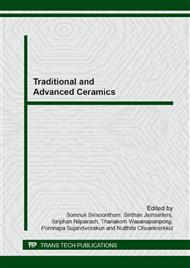p.264
p.274
p.280
p.289
p.295
p.301
p.307
p.311
p.316
Low Melting Glass Billets for Pot Furnace Glass Processing
Abstract:
Soda-lime-silica glasses were prepared by the composition range of SiO2 67-72, Na2O+K2O 15-18, CaO+MgO 5-8, BaO 2-4 and ZnO 2 in wt% for producing low melting glass billets. The billet properties were similar to commercial glasses, but higher melting ability. Respecting to thermodynamic calculation approach, the exploited heat (Hex), which was the required heat for melting the batch from atmosphere temperature to the melting temperature, was calculated in order to compare the melting ability. The results represented that glass batches with lower silica content which possessed lower Hex than batch with higher silica and consequently higher melting ability. Therefore, to reduce melting energy, silica content in batches should be as low as possible. Hex of batch with SiO2 67 wt% was 480 kWh/t, while the batch with SiO2 72 wt% was higher, namely 495 kWh/t. In addition, the glass batch with SiO2 67 wt% was completely melted at 1350 °C only. Properties of billets were determined, and the coefficient of thermal expansion was 9.6 x 10-6 °C-1. The glass transition point was 535 °C, and the refractive index was approximately 1.52. The study succeeded in producing glass billets with good quality and with melting temperatures lower than 1400 °C.
Info:
Periodical:
Pages:
295-300
Citation:
Online since:
April 2014
Keywords:
Price:
Сopyright:
© 2014 Trans Tech Publications Ltd. All Rights Reserved
Share:
Citation:


